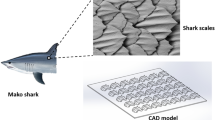Abstract
This work is motivated by the significant efforts aimed at improving the aerodynamic performance of navigating objects using bio-inspired surface modification. Inspired by the tooth-like denticles over sharkskin, this work describes the experimental study on a surface-modified structured torpedo prototype. This work studies the effects of uniform inflow on the drag properties and wake structure of flow over the torpedo prototype. The torpedo is fabricated in-house with a 3D printer. The experiments are performed in low turbulence, open circuit subsonic wind tunnel with Hotwire anemometer for data acquisition. The analysis is done for inflow velocity varying between 2-10 m/s with and without riblet surfaces. The maximum Reynolds number for the study is 4.2×105. The velocity and fluctuation analysis shows the variation in wake width and wake velocity for different surfaces. The study reveals that riblets structure enhances the momentum flux, thus enable the surface to reduce drag for adverse pressure gradients. The result showed that riblet effectively reduces drag coefficient by 10.5% at 4m/s. The results show the perspective to improve the current research status by using riblet surface for marine application.
Access this chapter
Tax calculation will be finalised at checkout
Purchases are for personal use only
Preview
Unable to display preview. Download preview PDF.
Similar content being viewed by others
References
D. W. Bechert, M. Bruse, W. Hage, and R. Meyer, Fluid mechanics of biological surfaces and their technological application, Naturwissenschaften, 87, 2000, pp. 157-171. DOI:https://doi.org/10.1007/s001140050696
D. W. Bechert and W. Hage, Drag Reduction with Riblets in Nature and Engineering, WIT Transactions on State-of-the-art in Science and Engineering, 4, 2006, pp. 458-469.
B. Dean, and B. Bhushan, Shark-Skin Surfaces for Fluid-Drag Reduction in Turbulent Flow: A Review, Philos. Trans. R. Soc., A, 368(1929), 2010, pp. 4775–4806
G. R. Grek, V. V. Kozlov, S. V. Titarenko and B. G. B. Klingmann, The influence of riblets on a boundary layer with embedded streamwise vortices, Physics of Fluids, 7, 1995, 2504.
M. J. Walsh, and L. M.Weinstein, Drag and heat transfer on surfaces with small longitudinal fins, AIAA Paper 78-1161, Proc. 11th Fluid and Plasma Dynamics Conference, 1978, Seattle, WA, U.S.A.
D. W. Bechert, M. Bruse, W. Hage, J. G. T. Van der Hoeven, and G. Hoppe, Experiments on drag-reducing surfaces and their optimization with an adjustable geometry, J. Fluid Mech., 7, 1997, pp. 338:59-87. DOI: https://doi.org/10.1017/S0022112096004673
P. R. Viswanath, Aircraft viscous drag reduction using riblets, Prog. Aerosp. Sci., 38, 2002, pp. 571-600. DOI: https://doi.org/10.1016/S0376-0421(02)00048-9
Torpedo Profile: https://www.ptboat.com/torpedo/torpedo.html
H. Schlichting, Boundary Layer Theory, 7th edition, McGraw Hill, 1979
Author information
Authors and Affiliations
Corresponding author
Editor information
Editors and Affiliations
Rights and permissions
Copyright information
© 2023 The Author(s), under exclusive license to Springer Nature Singapore Pte Ltd.
About this paper
Cite this paper
Sharma, V., Dutta, S. (2023). Experimental analysis of Surface-modified Structured Torpedo model. In: Bhattacharyya, S., Verma, S., Harikrishnan, A.R. (eds) Fluid Mechanics and Fluid Power (Vol. 3). FMFP 2021. Lecture Notes in Mechanical Engineering. Springer, Singapore. https://doi.org/10.1007/978-981-19-6270-7_14
Download citation
DOI: https://doi.org/10.1007/978-981-19-6270-7_14
Published:
Publisher Name: Springer, Singapore
Print ISBN: 978-981-19-6269-1
Online ISBN: 978-981-19-6270-7
eBook Packages: EngineeringEngineering (R0)




